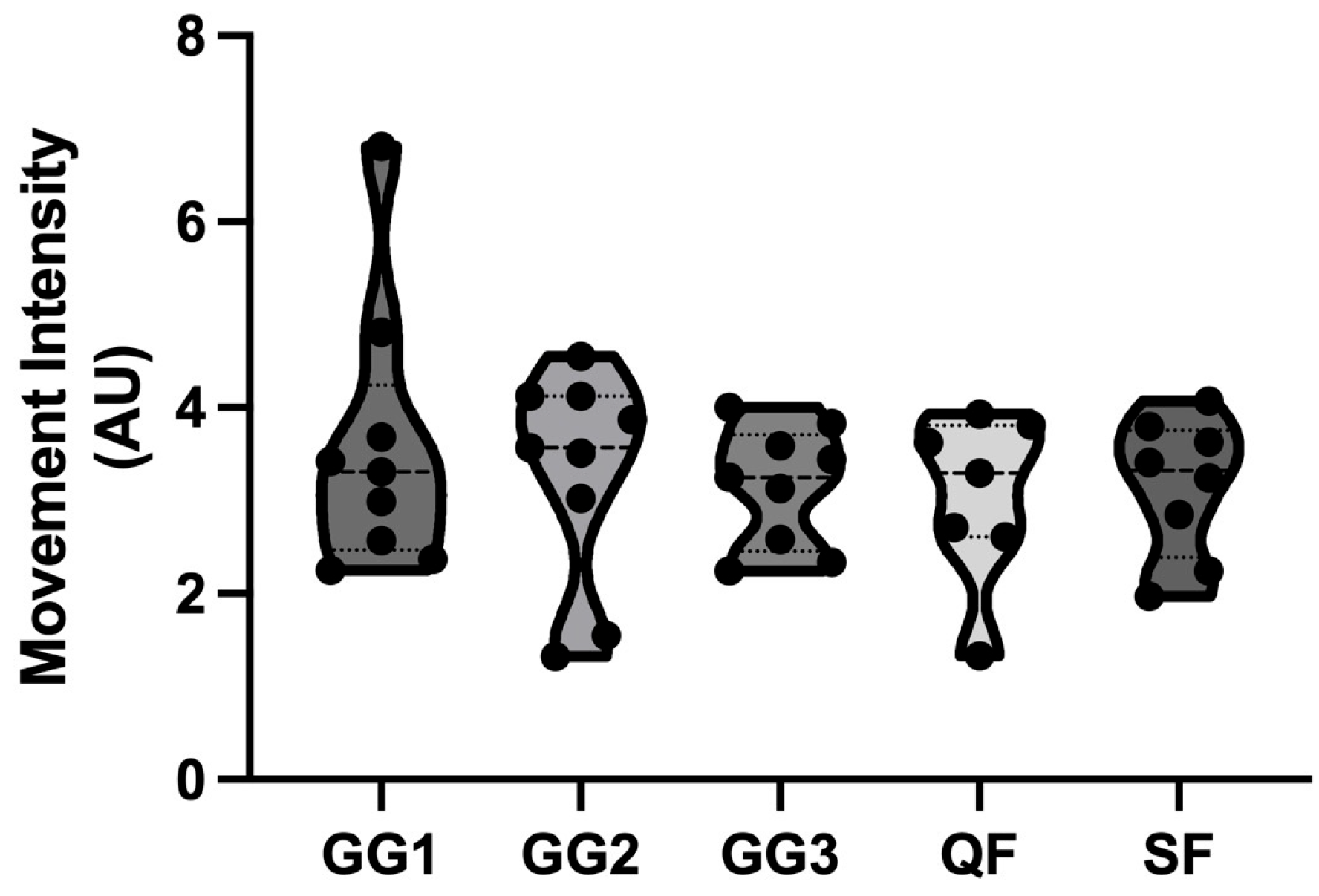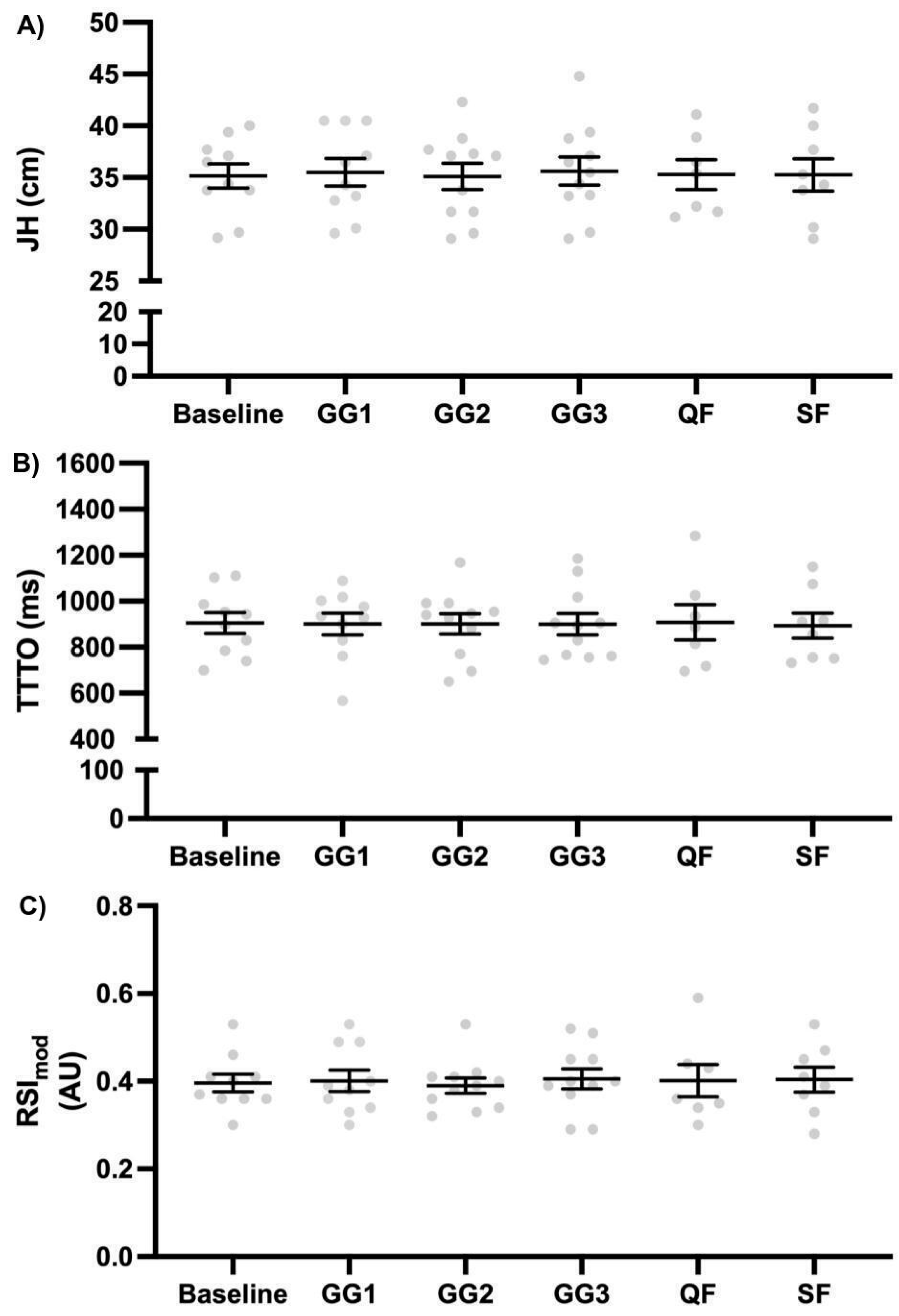Physical Demands and Acute Neuromuscular Responses Across a Single-Day 3 × 3 Male Basketball Tournament
Abstract
1. Introduction
2. Materials and Methods
2.1. Participants and Design
2.2. Tournament Structure
2.3. External Intensity Monitoring
2.4. Neuromuscular Status
2.5. Statistical Analyses
3. Results
4. Discussion
5. Conclusions
Author Contributions
Funding
Institutional Review Board Statement
Informed Consent Statement
Data Availability Statement
Conflicts of Interest
Abbreviations
| CMJ | Countermovement jump |
| ES | Effect size |
| GG1 | Group game 1 |
| GG2 | Group game 2 |
| GG3 | Group game 3 |
| JH | Jump height |
| MI | Movement Intensity |
| QF | Quarterfinals |
| RSImod | Modified Reactive Strength Index |
| SF | Semifinals |
| SWC | Smallest worthwhile change |
| TTTO | Time to take-off |
References
- Sansone, P.; Conte, D.; Tessitore, A.; Rampinini, E.; Ferioli, D. A Systematic Review on the Physical, Physiological, Perceptual, and Technical–Tactical Demands of Official 3 × 3 Basketball Games. Int. J. Sports Physiol. Perform. 2023, 18, 1233–1245. [Google Scholar] [CrossRef] [PubMed]
- Halson, S.L. Monitoring Training Load to Understand Fatigue in Athletes. Sports Med. 2014, 44, 139–147. [Google Scholar] [CrossRef]
- Palmer, J.A.; Bini, R.R.; Wundersitz, D.W.T.; Kingsley, M.I.C. Residual neuromuscular fatigue influences subsequent on-court activity in basketball. Eur. J. Sport Sci. 2023, 23, 1077–1084. [Google Scholar] [CrossRef]
- Ferioli, D.; Rampinini, E.; Conte, D.; Rucco, D.; Romagnoli, M.; Scanlan, A. Physical demands during 3 × 3 international male and female basketball games are partially impacted by competition phase but not game outcome. Biol. Sport 2023, 40, 377–387. [Google Scholar] [CrossRef]
- Impellizzeri, F.M.; Marcora, S.M.; Coutts, A.J. Internal and External Training Load: 15 Years On. Int. J. Sports Physiol. Perform. 2019, 14, 270–273. [Google Scholar] [CrossRef] [PubMed]
- Li, F.; Li, Z.; Borović, I.; Rupčić, T.; Knjaz, D. Does fatigue affect the kinematics of shooting in female basketball? Int. J. Perform. Anal. Sport 2021, 21, 754–766. [Google Scholar] [CrossRef]
- Bourdas, D.I.; Travlos, A.K.; Souglis, A.; Gofas, D.C.; Stavropoulos, D.; Bakirtzoglou, P. Basketball Fatigue Impact on Kinematic Parameters and 3-Point Shooting Accuracy: Insights across Players’ Positions and Cardiorespiratory Fitness Associations of High-Level Players. Sports 2024, 12, 63. [Google Scholar] [CrossRef] [PubMed]
- Claudino, J.G.; Cronin, J.; Mezêncio, B.; McMaster, D.T.; McGuigan, M.; Tricoli, V.; Amadio, A.C.; Serrão, J.C. The countermovement jump to monitor neuromuscular status: A meta-analysis. J. Sci. Med. Sport 2017, 20, 397–402. [Google Scholar] [CrossRef]
- Bishop, C.; Jarvis, P.; Turner, A.; Balsalobre-Fernandez, C. Validity and Reliability of Strategy Metrics to Assess Countermovement Jump Performance Using the Newly Developed My Jump Lab Smartphone Application. J. Hum. Kinet. 2022, 83, 185–195. [Google Scholar] [CrossRef]
- Bishop, C.; Jordan, M.; Torres-Ronda, L.; Loturco, I.; Harry, J.; Virgile, A.; Mundy, P.; Turner, A.; Comfort, P. Selecting Metrics That Matter: Comparing the Use of the Countermovement Jump for Performance Profiling, Neuromuscular Fatigue Monitoring, and Injury Rehabilitation Testing. Strength Cond. J. 2023, 45, 545–553. [Google Scholar] [CrossRef]
- McKay, A.K.A.; Stellingwerff, T.; Smith, E.S.; Martin, D.T.; Mujika, I.; Goosey-Tolfrey, V.L.; Sheppard, J.; Burke, L.M. Defining Training and Performance Caliber: A Participant Classification Framework. Int. J. Sports Physiol. Perform. 2022, 17, 317–331. [Google Scholar] [CrossRef] [PubMed]
- Conte, D.; Rampinini, E.; Trimarchi, F.; Ferioli, D. Interunit Reliability of Firstbeat Sport Sensors as Accelerometer-Based Tracking Devices in Basketball. Int. J. Sports Physiol. Perform. 2025, 20, 727–730. [Google Scholar] [CrossRef] [PubMed]
- Sansone, P.; Tessitore, A.; Makivic, B.; Ferioli, D.; Conte, D. The relationships between training load models in 3 × 3 basketball games. Int. J. Sports Physiol. Perform. 2025, 20, 684–688. [Google Scholar] [CrossRef] [PubMed]
- Ferioli, D.; Alcaraz, P.E.; Alcaraz, T.T.; Trimarchi, F.; Conte, D.; Formica, L.; Chung, L.H.; Scanlan, A.T. The reliability and discriminant validity of physical, technical, and perceptual-physiological measures during a game-specific basketball activity simulation protocol. Front. Psychol. 2024, 15, 1414339. [Google Scholar] [CrossRef]
- Rago, V.; Brito, J.; Figueiredo, P.; Carvalho, T.; Fernandes, T.; Fonseca, P.; Rebelo, A. Countermovement jump analysis using different portable devices: Implications for field testing. Sports 2018, 6, 91. [Google Scholar] [CrossRef]
- Pueo, B.; Hopkins, W.G.; Penichet-Tomas, A.; Jimenez-Olmedo, J.M. Accuracy of flight time and countermovement-jump height estimated from videos at different frame rates with MyJump. Biol. Sport 2023, 40, 595–601. [Google Scholar] [CrossRef]
- Al Haddad, H.; Simpson, B.M.; Buchheit, M. Monitoring Changes in Jump and Sprint Performance: Best or Average Values? Int. J. Sports Physiol. Perform. 2015, 10, 931–934. [Google Scholar] [CrossRef]
- Balsalobre-Fernández, C.; Glaister, M.; Lockey, R.A. The validity and reliability of an iPhone app for measuring vertical jump performance. J. Sports Sci. 2015, 33, 1574–1579. [Google Scholar] [CrossRef]
- Gençoğlu, C.; Ulupınar, S.; Özbay, S.; Turan, M.; Savaş, B.Ç.; Asan, S.; İnce, İ. Validity and reliability of ‘My Jump app’ to assess vertical jump performance: A meta-analytic review. Sci. Rep. 2023, 13, 20137. [Google Scholar] [CrossRef]
- Turner, A.N.; Parmar, N.; Jovanoski, A.; Hearne, G. Assessing group-based changes in high-performance sport. Part 2: Effect sizes and embracing uncertainty through confidence intervals. Strength Cond. J. 2021, 4, 68. [Google Scholar] [CrossRef]
- Hopkins, W.G. Measures of Reliability in Sports Medicine and Science. Sports Med. 2000, 30, 1–15. [Google Scholar] [CrossRef] [PubMed]
- Haugen, T.; Buchheit, M. Sprint Running Performance Monitoring: Methodological and Practical Considerations. Sports Med. 2016, 46, 641–656. [Google Scholar] [CrossRef]
- Hopkins, W.G. How to Interpret Changes in an Athletic Performance Test. Sportscience 2004, 8, 1–7. [Google Scholar]
- Willberg, C.; Wellm, D.; Behringer, M.; Zentgraf, K. Analyzing acute and daily load parameters in match situations—A comparison of classic and 3 × 3 basketball. Int. J. Sports Sci. Coach. 2023, 18, 207–219. [Google Scholar] [CrossRef]
- Ferioli, D.; Conte, D.; Rucco, D.; Alcaraz, P.E.; Vaquera, A.; Romagnoli, M.; Rampinini, E. Physical demands of elite male and female 3 × 3 international basketball matches. J. Strength Cond. Res. 2023, 37, e289–e296. [Google Scholar] [CrossRef]
- Pernigoni, M.; Ferioli, D.; Calleja-González, J.; Sansone, P.; Tessitore, A.; Scanlan, A.T.; Conte, D. Match-related fatigue in basketball: A systematic review. J. Sports Sci. 2024, 18, 1727–1758. [Google Scholar] [CrossRef]
- Ferioli, D.; Bosio, A.; Bilsborough, J.C.; La Torre, A.; Tornaghi, M.; Rampinini, E. The preparation period in basketball: Training load and neuromuscular adaptations. Int. J. Sports Physiol. Perform. 2018, 13, 991–999. [Google Scholar] [CrossRef]


| Movement Intensity | |
|---|---|
| Player 1 | 2.63 ± 0.89 |
| Player 2 | 5.40 ± 1.99 |
| Player 3 | 4.27 ± 0.73 |
| Player 4 | 3.19 ± 0.60 |
| Player 5 | 1.72 ± 0.47 |
| Player 6 | 3.46 ± 0.24 |
| Player 7 | 3.19 ± 0.59 |
| Player 8 | 3.55 ± 0.59 |
| Player 9 | 3.17 ± 0.75 |
| Player 10 | 2.85 ± 0.36 |
| Player 11 | 3.44 ± 0.96 |
| Player 12 | 2.28 ± 0.77 |
| Variable | AIC | F | p | Random-Effects Variance | Residual Variance |
|---|---|---|---|---|---|
| Movement Intensity | 119.994 | 0.922 | 0.466 | 0.705 | 0.523 |
| Jump Height | 269.826 | 0.516 | 0.762 | 12.99 | 2.83 |
| Time to Take-Off | 725.31150 | 0.107 | 0.990 | 14,000 | 8761 |
| Modified Reactive Strength Index | −159.883 | 0.223 | 0.951 | 0.003 | 0.001 |
Disclaimer/Publisher’s Note: The statements, opinions and data contained in all publications are solely those of the individual author(s) and contributor(s) and not of MDPI and/or the editor(s). MDPI and/or the editor(s) disclaim responsibility for any injury to people or property resulting from any ideas, methods, instructions or products referred to in the content. |
© 2025 by the authors. Licensee MDPI, Basel, Switzerland. This article is an open access article distributed under the terms and conditions of the Creative Commons Attribution (CC BY) license (https://creativecommons.org/licenses/by/4.0/).
Share and Cite
Sansone, P.; Rago, V.; Alonso-Perez-Chao, E.; Zhang, S.; Conte, D. Physical Demands and Acute Neuromuscular Responses Across a Single-Day 3 × 3 Male Basketball Tournament. Sensors 2025, 25, 3296. https://doi.org/10.3390/s25113296
Sansone P, Rago V, Alonso-Perez-Chao E, Zhang S, Conte D. Physical Demands and Acute Neuromuscular Responses Across a Single-Day 3 × 3 Male Basketball Tournament. Sensors. 2025; 25(11):3296. https://doi.org/10.3390/s25113296
Chicago/Turabian StyleSansone, Pierpaolo, Vincenzo Rago, Enrique Alonso-Perez-Chao, Shaoliang Zhang, and Daniele Conte. 2025. "Physical Demands and Acute Neuromuscular Responses Across a Single-Day 3 × 3 Male Basketball Tournament" Sensors 25, no. 11: 3296. https://doi.org/10.3390/s25113296
APA StyleSansone, P., Rago, V., Alonso-Perez-Chao, E., Zhang, S., & Conte, D. (2025). Physical Demands and Acute Neuromuscular Responses Across a Single-Day 3 × 3 Male Basketball Tournament. Sensors, 25(11), 3296. https://doi.org/10.3390/s25113296









